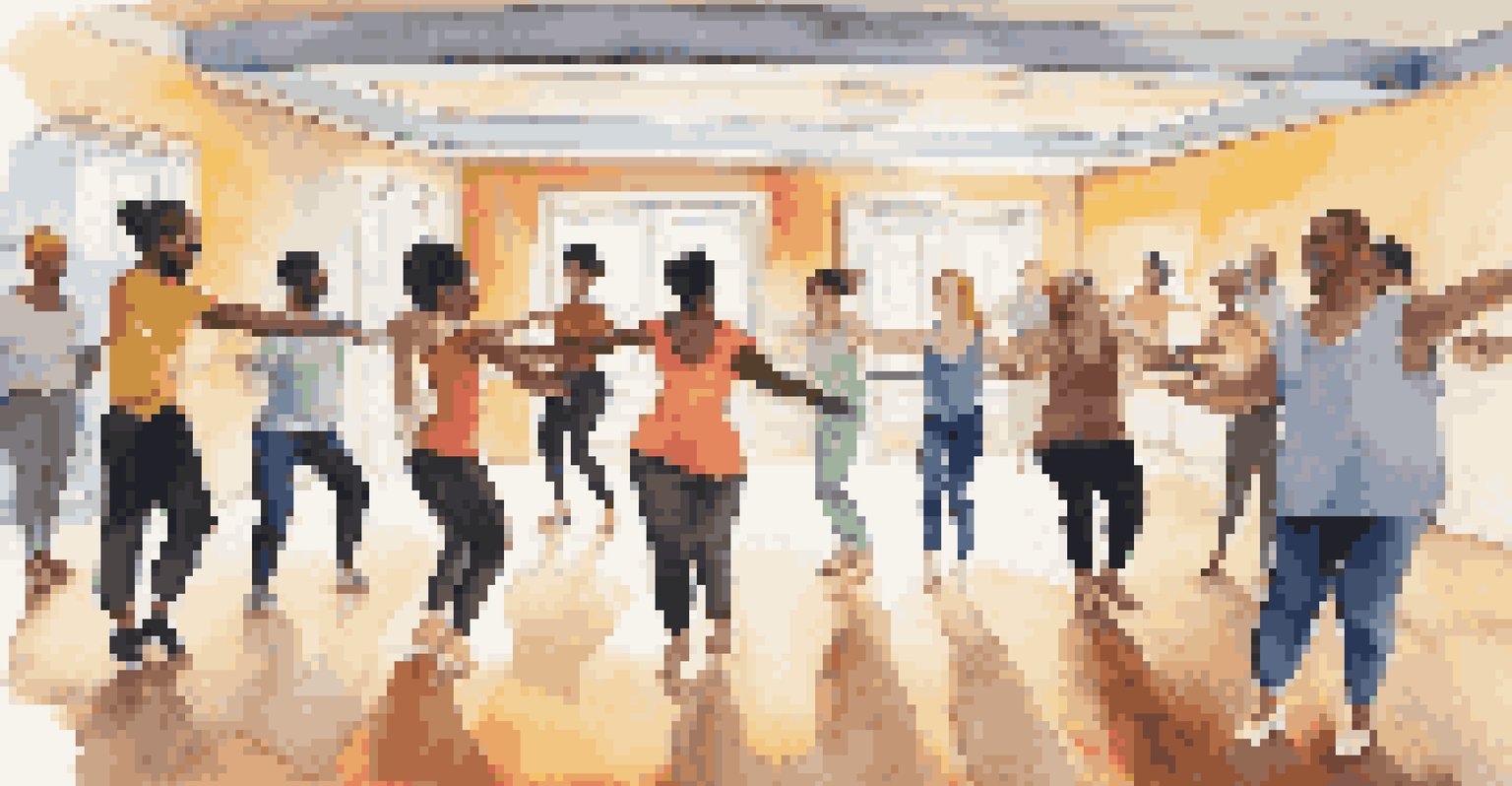Dance Therapy: The Future of Movement for Mental Well-being

Understanding Dance Therapy and Its Origins
Dance therapy, or dance/movement therapy (DMT), is a therapeutic approach that uses movement to promote emotional, cognitive, and physical integration. It emerged in the 1940s, when therapists recognized the healing power of dance in expressing feelings and facilitating communication. This unique form of therapy combines psychology and the expressive arts, making it a rich avenue for self-exploration and healing.
Dance is the hidden language of the soul.
At its core, dance therapy encourages individuals to connect with their bodies and emotions through movement. By engaging in expressive movement, clients often uncover thoughts and feelings that may be difficult to articulate verbally. This non-verbal communication can be especially beneficial for those who struggle with traditional talk therapies.
Moreover, dance therapy is not limited to any particular style; it encompasses a variety of dance forms, allowing each participant to find what resonates with them. Whether it’s ballet, hip-hop, or contemporary dance, the focus is on personal expression and emotional connection, showcasing the versatility and inclusivity of this therapeutic practice.
The Science Behind Dance Therapy
Research has shown that dance therapy can significantly impact mental health by reducing symptoms of anxiety, depression, and PTSD. When we dance, our bodies release endorphins, the feel-good hormones, which can lead to improved mood and emotional well-being. Furthermore, engaging in rhythmic movements can help regulate stress responses, providing a natural way to cope with life’s challenges.

Studies suggest that the brain's neuroplasticity—its ability to reorganize itself—can be enhanced through movement. Dance therapy encourages new neural pathways, promoting emotional resilience and cognitive flexibility. This means that participants not only feel better during sessions but can also carry these benefits into their daily lives.
Dance Therapy Promotes Healing
Dance therapy utilizes movement to help individuals express emotions, enhance communication, and facilitate healing.
Additionally, the social aspect of dance therapy fosters a sense of community and support among participants. Group sessions create a safe space for sharing experiences and building connections, which is essential for mental health. This camaraderie can be a powerful motivator, encouraging individuals to face their emotions and challenges together.
Who Can Benefit from Dance Therapy?
Dance therapy is inclusive and can benefit individuals of all ages, backgrounds, and abilities. Children, adolescents, adults, and older adults can find joy and healing through movement, making it a versatile option for various populations. Whether someone is dealing with trauma, chronic illness, or simply seeking personal growth, dance therapy offers a pathway to self-discovery.
Movement is a medicine for creating change in a person's physical, emotional, and mental states.
Particularly beneficial for those who find it hard to express themselves verbally, dance therapy provides an alternative means of communication. Individuals on the autism spectrum or those with speech and language difficulties may find that movement allows them to express themselves in ways they previously could not. This creates an empowering experience that fosters self-acceptance and confidence.
Moreover, dance therapy is also gaining traction in rehabilitation settings, where it aids in recovery from physical injuries and enhances overall well-being. By focusing on movement, individuals regain strength and mobility while simultaneously addressing any emotional challenges that arise during their healing journey.
How Dance Therapy Works in Practice
Dance therapy sessions typically involve a combination of guided movement and improvisation. A trained dance therapist leads participants through a series of activities designed to explore emotions and physical sensations. This might include structured movements, free dance, or even creative visualization, all tailored to meet the needs of the group or individual.
Throughout the process, participants are encouraged to listen to their bodies and express their feelings through movement. This experiential learning allows for a deeper understanding of one’s emotions and how they manifest physically. For instance, someone may realize that tension in their shoulders corresponds to feelings of anxiety, leading to insights that can be explored further in therapy.
Benefits for Diverse Populations
This therapeutic approach is beneficial for people of all ages and backgrounds, particularly those who struggle with verbal expression.
Importantly, the therapist provides a supportive environment where participants can feel safe to explore and express themselves. They offer guidance and feedback, helping clients to navigate their emotions while fostering growth and healing. This collaborative relationship is key to the effectiveness of dance therapy, creating a nurturing space for transformation.
Dance Therapy and Mindfulness
An essential component of dance therapy is mindfulness, which encourages individuals to be present in the moment. By focusing on the sensations of movement, participants can cultivate a deeper awareness of their bodies and emotions. This practice not only enhances the therapeutic experience but also promotes overall mental well-being.
Mindfulness in dance therapy can help reduce racing thoughts and anxiety, allowing individuals to immerse themselves in the rhythm of the music and their movements. This meditative aspect offers a break from daily stressors, fostering a sense of calm and clarity. As participants become more attuned to their bodies, they often discover new ways to cope with challenges in their lives.
Additionally, the mindfulness fostered through dance therapy can extend beyond the sessions. Participants may find themselves incorporating mindful movement into their daily routines, whether through walking, stretching, or even dancing at home. This integration of mindfulness can create lasting positive changes in their mental health and overall quality of life.
The Future of Dance Therapy in Mental Health
As mental health awareness continues to grow, so does the recognition of alternative therapies like dance therapy. With more research supporting its effectiveness, dance therapy is gaining traction in clinical settings and wellness communities alike. This shift indicates a broader acceptance of holistic approaches to mental well-being, reflecting the diverse needs of individuals seeking help.
The future of dance therapy also includes advancements in technology, such as virtual sessions and online workshops. These innovations make dance therapy more accessible to those who may not have local resources or who prefer the comfort of their homes. By embracing technology, dance therapy can reach a wider audience, breaking down barriers to mental health support.
Mindfulness Enhances Therapy
Incorporating mindfulness into dance therapy fosters a deeper awareness of emotions and promotes overall mental well-being.
Moreover, as more professionals integrate dance therapy into traditional treatment plans, we can expect to see a more comprehensive approach to mental health care. Combining dance therapy with other modalities, such as cognitive behavioral therapy (CBT) or art therapy, can enhance overall treatment outcomes, providing individuals with a richer and more personalized healing experience.
Final Thoughts on Dance Therapy
In a world where mental health challenges are increasingly prevalent, dance therapy offers a refreshing and effective approach to healing. By harnessing the power of movement, individuals can explore their emotions, build connections, and foster resilience. The beauty of dance therapy lies in its ability to adapt to each person’s unique journey, making it a truly individualized experience.
Whether you are seeking a new form of therapy or simply curious about the benefits of movement, dance therapy presents an exciting opportunity for growth and self-discovery. It invites you to reconnect with your body, embrace your emotions, and find joy in movement, all while fostering a deeper understanding of yourself.

As we look to the future, dance therapy stands poised to play a vital role in the mental health landscape, offering hope and healing for those who need it most. Embracing the rhythm of life through dance can be the key to unlocking a brighter, more balanced future.